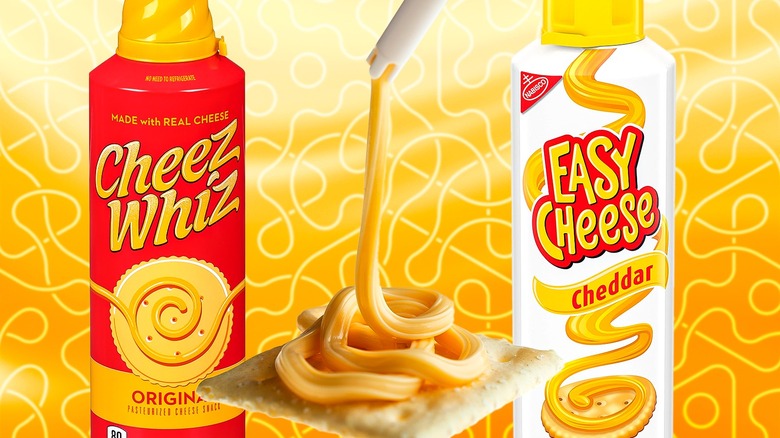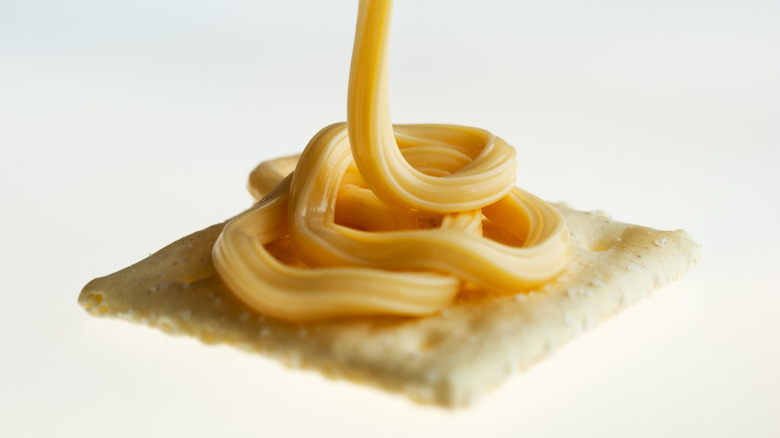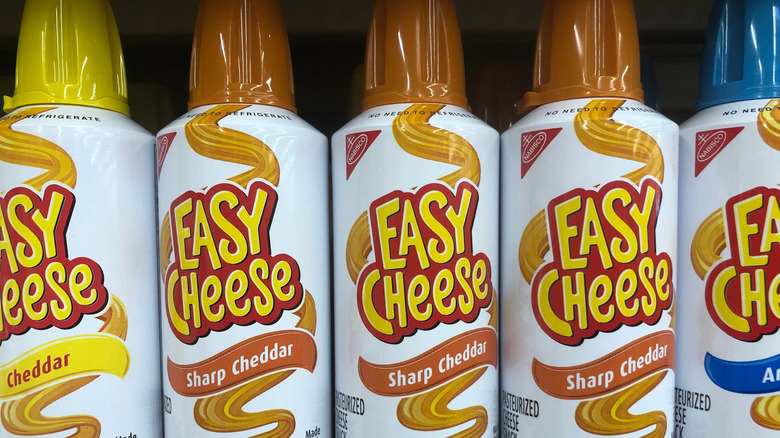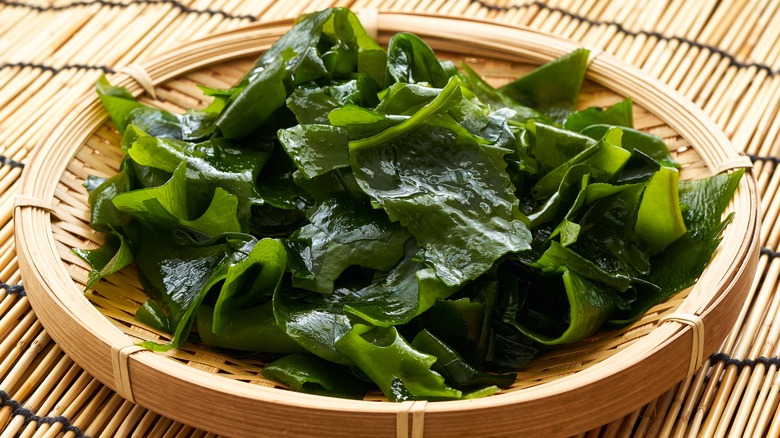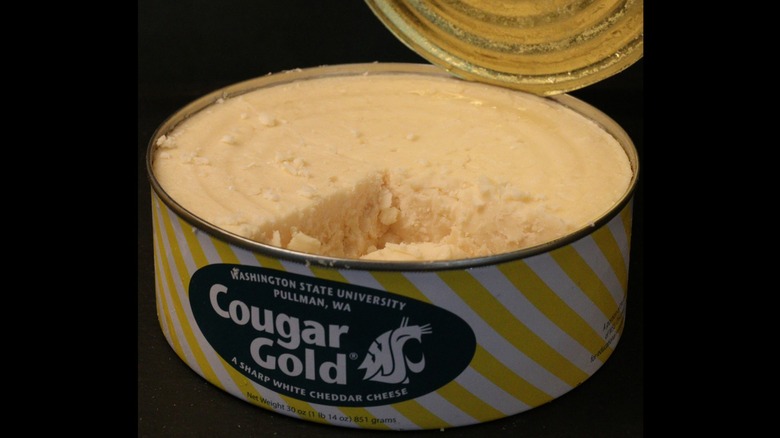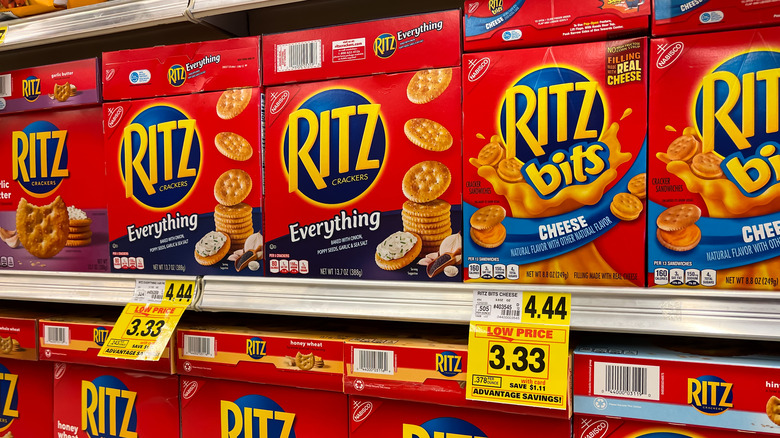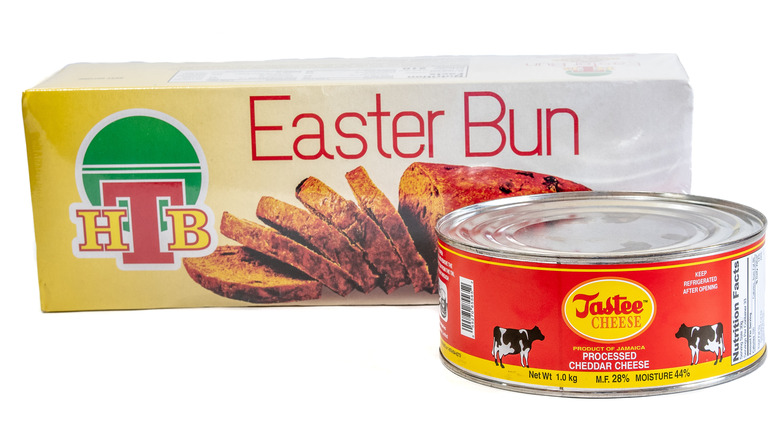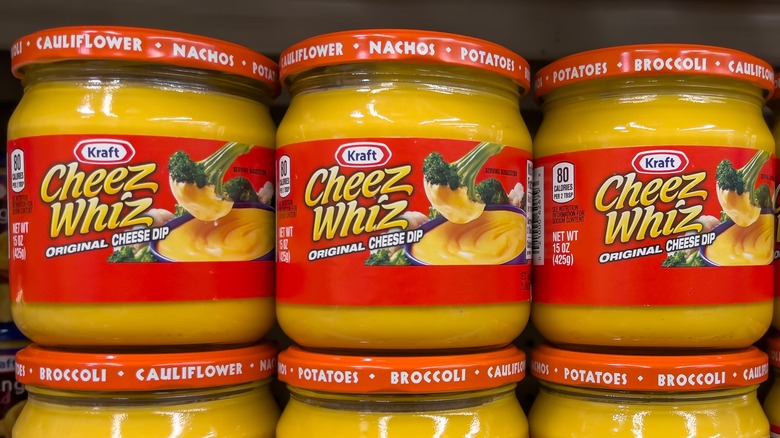12 Facts You Should Know About Canned Cheese
Canned foods like evaporated milk, beans, and tuna thread our lives with ease and convenience. However, among the range of processed foods many keep stocked in their pantries, canned cheese stands out from the crowd as particularly unnatural and, frankly, odd.
Though most can agree that canned cheese is a bizarre invention, it's a bit more difficult to pin down the exact reason why — perhaps because there are so many possibilities. Is it the distinct orange color reminiscent of American cheese? Could it be the way it goes by many aliases, such as aerosol cheese, spray cheese, squirty cheese (thank you, United Kingdom), and easy cheese? What makes canned cheese a fluorescence triumph to some but a gelatinous atrocity to others? Why does this American icon make countries with more refined cheese histories cringe in fear and disgust?
Whether you're a celebrator or a skeptic of this confusing, cheesy concoction, it's difficult to deny the intrigue of canned cheese. Here, we explore the history, ingredients, and secrets of one of the world's most mysterious food products.
Canned cheese was invented during World War I and sent to the troops
To understand the origins of tinned cheese as we know it, we have to take a trip back to World War I. In 1915, James L. Kraft (yes, founder of the Kraft Mac & Cheese you're thinking of) was on a mission to uncover a way for cheese to "be kept indefinitely without spoiling." Improving on the innovation of the Swiss cheese makers who invented the first commercially processed cheese in 1911, Kraft earned the first U.S. patent for processed cheese in 1916. He then supplied 6 million pounds of his product to the armed forces.
The success of canned cheese during WWI led to an increased demand in the following years. Other companies, such as Borden, went into competition with Kraft, marketing their products as convenient snacks suitable for anyone who might find themselves far away from home or a kitchen at any given time. Canned cheese quickly rose in popularity and became one of America's most beloved convenience foods, appearing everywhere from camping trips to school lunches.
A Washington State professor invented a canned cheese that's actually cheese
Though it's on the ingredients list, cheese is not the star of the show in most canned cheese imitations like Easy Cheese and Cheez Whiz. The main ingredients are whey and canola oil, which contribute to the distinct, not-so-cheesy flavor. So, does a canned-cheese-that-actually-tastes-like-cheese unicorn exist? Yes.
Spearheaded in the 1940s by Washington State University food science professor Norman Shirley Golding, Cougar Gold cheese, the darling of WSU, subverts all expectations of what a canned cheese can be. The cheddar-style cheese is made with whole milk and aged for two months, giving it a unique flavor and texture. The cheese is then sealed into steel cans lined with a wax coating that helps preserve it and give it its distinct aroma.
Unlike other canned cheeses, Cougar Gold does not use emulsifiers or any aerosol propellants to create its creamy texture. Instead, the cheese's signature creaminess comes from its high-fat content and aging process. When heated up on toast or in macaroni and cheese, Cougar Gold's creamy consistency melts down beautifully without leaving behind any greasy residue. Its mild cheddar flavor also makes it popular as a snack or topping for salads and sandwiches.
Spray cheese is not an aerosol
Though we're sure he'd like to, James L. Kraft can't take credit for spray cheese in a can. Nabisco first manufactured Easy Cheese and sold it under the name "Snack Mate" from 1965 until 1984, marketing it as an instant cheese for instant parties. Despite going by the alias "aerosol cheese," spray cheeses like Easy Cheese are not true aerosols. Though the can looks like a singular entity, a spray cheese has two sections: one stating that the bottom is filled with nitrogen gas, and one stating that the top must be filled with cheese or something cheese adjacent.
When you press the nozzle down to disperse the product on a cracker or directly into your mouth (no judgment here), the nitrogen pressure pushes the cheese out of the can. A plastic barrier prevents the propellant at the bottom of the can from ever touching the product. This enables spray cheese to come out luxuriously in those pretty little floret patterns rather than leaving your face covered in a fluorescent mist.
Canned cheese has some surprising ingredients
Canned cheese has some unusual ingredients hiding inside. Many people assume that canned cheese is made from just milk, salt, and emulsifiers, but there are many expected and unexpected additives in the mix. Some are natural ingredients such as brown seaweed extract, which serves as an emulsifier. Others are classic artificial components like sodium benzoate or potassium sorbate, which act as preservatives.
Other common ingredients across canned and spray cheeses include food coloring agents like annatto and carotenoids (you can thank them for that signature bright orange hue). Many brands also use cellulose gum, a stabilizing agent derived from wood pulp or plant fiber. Calcium chloride is often added to make sure that the cheese doesn't separate out during canning. Finally, citric acid often guest stars to give the cheese a tangy flavor profile.
Although some of these ingredients may sound, um, scary, it's important to remember that they have been tested for safety by regulatory bodies such as the United States Food and Drug Administration and approved for use in canned cheese production. While you should always read labels before buying any food product, don't be too alarmed if you see some unfamiliar names listed on your can of cheese — they probably won't do you any harm!
Cougar Gold can last indefinitely in the fridge
What really sets Cougar Gold apart from other types of cheese is its ability to last indefinitely in the fridge. As long as the can is unopened and refrigerated, Cougar Gold doesn't spoil or go bad — making it ideal for those who want to store large amounts of cheese without having to worry about expiration dates. In fact, Cougar Gold has been known to stay fresh for over 25 years.
This isn't just a cool fact — it also makes economic sense: by buying Cougar Gold in bulk, you can save yourself money (and trips to the grocery store) in the long run. Plus, since Cougar Gold doesn't need to be frozen or stored at room temperature, you can keep more of your food budget in check while still enjoying delicious cheesy goodness.
Of course, no matter how long your Cougar Gold lasts, it should be noted that once opened and exposed to air, all cheeses will begin to degrade fairly quickly — even if they are stored in the refrigerator. So make sure you eat up any unopened cans before their expiration date!
Snack Mate canned cheese was launched to boost cracker sales
In the early 1980s, Nabisco made a bold attempt to bolster its cracker sales by introducing a new product: Snack Mate canned cheese. The bright idea was that consumers could buy both the crackers and the cheese in one convenient package. The combination had never been more easily accessible. It was an immediate hit with customers, who were excited to have a quick and easy way to make snacks like grilled cheese sandwiches or nachos.
The owner of Nabisco was enthusiastic about Snack Mate's potential to provide an assist for their line of snack foods. He believed it would be a great addition to their existing products, as well as giving them an edge over competitors in the market. Not surprisingly, Snack Mate quickly became a success. It's amazing what some creative thinking can do when trying to give your product line a boost.
Canned cheese is an Easter staple in Jamaica
In Jamaica, canned cheese is a beloved Easter tradition. As the only company in the country that manufactures processed cheese, Tastee Cheese has been providing families on the island with a delicious and convenient way to enjoy their favorite holiday meals for generations. During the weeks leading up to Easter, Tastee Cheese cans can be found in almost every grocery store and market in Jamaica.
The canned cheese is most often served as part of a traditional Jamaican dish called "Easter Bun" — a spiced fruit cake served with melted cheese and butter. This combination of sweet and savory flavors makes it an instant crowd-pleaser during holiday celebrations. The convenience of having pre-made cheese ready to go makes it even easier for busy cooks to get their holiday meals prepared quickly and easily.
In addition to being an Easter favorite, Tastee Cheese is also popular year-round among Jamaicans who appreciate its flavor and convenience. It's no wonder that the company has been able to stay in business for so many years.
You can make spray cheese at home ... kind of
The preservatives in canned cheese make it a fear food for many. If you're scared of little sodium benzoate, you can skip the chemicals but keep the cheese by making this fun and healthy-ish version at home. The process is fairly simple and only requires a few basic ingredients. All you need is cheddar cheese, butter, garlic powder, onion powder, cream cheese, and skim milk. Shred the cheddar cheese and blend all the ingredients until combined into a smooth paste. Then transfer the mixture into an airtight container and refrigerate overnight.
The next day you can transfer the mixture to an aerosol can or whipped cream dispenser for easy spraying. You can also add additional seasonings to customize the flavor profile of your homemade sprayable cheese such as dried herbs or smoked paprika for some smoky heat. And don't shy away from canned tomatoes, aka the canned ingredient that takes cheese dip to the next level.
Making your own sprayable cheese at home provides several advantages over canned varieties while still giving you that cheesy flavor everyone loves. It's healthier since there are no preservatives in the recipe and it's also more economical since you're using fresh ingredients that cost less than cans of processed cheeses. Bonus: Making your own spray cheese at home with a reusable container saves cans from going into the landfill.
Selena Gomez's favorite late night snack involves canned cheese
Selena Gomez is no stranger to the world of canned cheese. As a self-proclaimed late-night snacker, she's always looking for quick and easy recipes to satisfy her cravings. Her go-to snack? A mini spray cheese pizza bite!
In an interview with Variety, Selena shared her signature recipe, which requires just four ingredients: a can of spray cheese, mini pizza shells, pepperoni slices, and Italian seasoning. After preheating the oven to 350 F, Selena sprinkles Italian seasoning onto each pizza shell before topping it with pepperoni slices and spraying the top generously with canned cheese. Once all pizzas are topped, they can be baked in the oven for 8-10 minutes or until golden brown.
The result is a delicious combination of crunchy shells, crispy pepperoni slices, and melty spray cheese that makes for the perfect late-night snack. Selena raves about how quick and easy this recipe is — it takes less than 20 minutes from start to finish — so it's ideal for those nights when you're craving something savory but don't have much time on your hands. Plus, you can customize this snack by adding additional toppings like bell peppers or olives.
Cheez Whiz enhanced the realism of HBO's Mare of Easttown
Cheez Whiz recently gained a new wave of fame due to its cameo on HBO's hit show "Mare of Easttown." The moment Kate Winslet sprayed Cheez Whiz on cheeseballs was the moment people truly believed in the show's rural Pennsylvania setting. This iconic product has become a symbol of authenticity and nostalgia for viewers all over the world.
This unlikely star-power began with an introduction by Philadelphia native Kevin Bacon, who played Detective Colin Zabel on the show. He quickly establishes that Cheez Whiz is a "local delicacy" that needs no explanation because "everyone knows what it is." His enthusiasm for this common ingredient captures the essence of life in small towns across America where simple pleasures like Cheez Whiz are celebrated.
The inclusion of Cheez Whiz goes beyond simply providing flavor or texture; it has become a representation of true rural Pennsylvania culture. It provides viewers with an insight into how locals view their own food culture and helps them connect with characters on a more personal level. The realism and authenticity created by this product have made it indispensable to creating believable settings for shows like "Mare of Easttown."
Canned cheese once caused a botulism outbreak in rural Georgia
In 1996, a botulism outbreak in rural Georgia was linked to canned cheese sauce. The incident prompted researchers to take a closer look at the product's ingredients and production process. The outbreak occurred when 21 people became ill after consuming canned cheese sauce purchased from a local grocery store. Three of those people were hospitalized and one died due to complications from botulism poisoning. After further investigation, it was determined that the cause of the outbreak was due to improperly processed cans of cheese sauce.
The problem with canned cheese is that some brands are produced using an outdated method known as "open-kettle" canning. This process involves heating the cheese ingredients in an open pot without boiling them first, which can lead to spoilage by allowing bacteria into the mixture during processing. It also results in low acidity levels, making it more prone to botulinum toxin growth — which is what happened in this particular case.
Nowadays, many companies use modernized methods such as "closed-kettle" or "aseptic" canning processes for their products. These newer techniques involve boiling all ingredients before they are sealed into cans and have proven effective at eliminating foodborne illnesses associated with canned cheeses such as botulism.
Consumers need to be aware of these risks when shopping for canned cheese. Be sure to check labels carefully for any signs of improper processing or expiration dates before purchasing any canned cheese products.
You can throw your own canned cheese party
Now that you know all the facts about canned cheese, there is plenty of opportunity to get creative. If you're eager to try our at-home squeeze cheese recipe, why not throw a party and invite friends over to experiment with different recipes using canned cheese? Have everyone bring their most unique or appalling dish made with canned cheese and have a taste-testing competition at the end.
No matter what you do with your newfound knowledge about canned cheese, remember that it is important to purchase from reputable brands and follow safety precautions if you decide to try making your own. Don't get botulism — enjoy your tasty canned cheese treats responsibly. And even if you don't feel like making a number of dishes, even sampling different canned cheeses can be an interesting way to explore this mysterious food. Unique cheeses are worth trying, and even if canned cheese doesn't quite fit the same bill as Brie Noir or burrata, perhaps you'll have some fun in the process.
